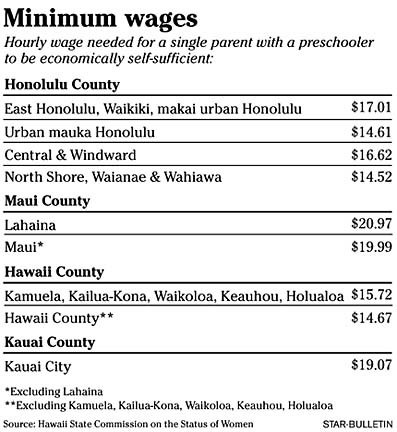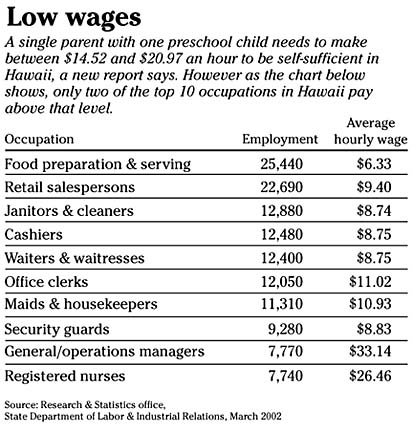
A single mother with one preschool-age child living in East Honolulu needs to earn $35,930 a year to pay for everything from housing, transportation and child care to taxes and health care and still get by without public assistance, according to a new study. Study gives clearer
picture of isle povertyFederal standards for government
programs fail to weigh Hawaii's
high cost of livingBy Sally Apgar
sapgar@starbulletin.comThe same single mother and child in Lahaina, where certain living costs are higher than Honolulu, would need $44,283, according to the study released yesterday by the Hawaii State Commission on the Status of Women. If that mother and child moved to Kailua-Kona on the Big Island, they would need $33,192.
But according to the federal poverty measure, which has often been criticized as unrealistic, that same family of two in Hawaii would be rated "not poor" if it makes $15,000 a year.
At a state Capitol news conference yesterday, the commission presented an economic study of Hawaii and a new "economic self-sufficiency" measure for the state that differs radically from traditional standards such as federal poverty guidelines.
The self-sufficiency measure determines what the minimum living expenses are for a family in a particular part of the state and what that family needs to earn so that it can pay bills without public assistance, social service programs or help from friends and family.
Recognizing that a family's expenses change with the age and number of children, the study factors in 70 different family combinations ranging from one working parent and a preschooler in full-time day care to two parents and three teens.
The federal poverty level, a 40-year-old standard that takes a one-size-fits-all approach, is largely based on food costs, adjusted for inflation but does not recognize geographical differences or the costs of health care, housing, child care, transportation and other basic costs.
Allicyn Hikida Tasaka, executive director of the commission, said the new standard measures "the level of income necessary to enable families to take the first steps toward economic independence. This objective view of what it costs for working families to make ends meet ... will be a useful tool for government, business leaders, service providers and nonprofits as they work together to design better programs and policies for Hawaii's working families."
The commission teamed with report author and researcher Diana Pearce, of the University of Washington and Wider Opportunities for Women, a 38-year-old national organization that focuses on women's employment and the pursuit of economic independence and equal opportunities for women. The study was funded as part of a larger grant from the Ford Foundation.
WOW and Pearce have completed similar studies for 33 other states where the measure is used by policy-makers to create legislation, for example, to get families off of welfare and back to work and to develop job-training and education programs.
Pearce acknowledged that Hawaii is one of the most expensive places they have studied. For a single mother and a preschooler, for example, Honolulu is the most expensive city after San Francisco and New York.
Pearce's study also quantifies the significant gap between hourly wages in the state and the annual income needed to survive on a "bare-bones, no-frills budget that doesn't include takeout food, Happy Meals (McDonald's) or lattes."
For example, the single mother and preschooler in East Honolulu need to earn $16.62 an hour. At $6.25 an hour, the Hawaii minimum wage is not a living wage for them. Unfortunately, Hawaii's service economy is dominated by low-wage jobs.
The study shows the average salesclerk makes $9.40 an hour, housekeepers make $8.83 and office clerks make $11.02. Of Hawaii's 10 largest occupations, only two -- registered nurses and operations managers -- make enough to support a single mom and a preschooler.
Pearce said "many families do not earn self-sufficiency wages, particularly if they have recently entered the work force." Pearce said that forces them "to make painful choices between necessities or to accept substandard or inadequate child care, insufficient food or substandard housing."
The study's authors say the answer is not more public assistance, but programs that will educate people so they can get higher-paying jobs. While people are working toward those jobs, the study suggests reducing some of their living costs with subsidies such as child-care assistance and food stamps.
Pearce said: "The downward turn in Hawaii's economy has had an enormous impact on the working families of this state, who are struggling to keep food on the table and a roof over their children's heads. We hope this new information can be used by legislators, business leaders, service providers and families themselves to understand the crucial role that both decent wages and work supports, such as child-care assistance, affordable housing and health-care assistance, can play in assisting working families in these tough economic times."
Hawaii State Commission on the Status of Women
Wider Opportunities for Women

